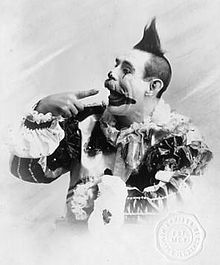| Ricardo Bell | |
|---|---|
 Promotional card of Bell, unknown date. Promotional card of Bell, unknown date. | |
| Born | Richard Bell Guest (1858-01-10)January 10, 1858 London |
| Died | March 12, 1911 New York |
| Years active | 1860–1911 |
| Children | 13 |
Ricardo Bell was the artistic name of Richard Bell Guest (London, January 10, 1858 – New York, March 12, 1911) an English clown and entrepreneur, famous in Mexico in the late 19th and early 20th centuries. After he became famous as the main actor of Circo Orrín, one of the famous circuses of Mexico City and by becoming the most successful clown in the country, Bell founded his own Gran Circo Ricardo Bell. The poet Juan de Dios Peza wrote in El Monitor Republicano newspaper about Bell that he "is more popular than pulque", in an epoch were the pulque was the preferred alcoholic beverage in Mexico.
Biography
He made his debut in Lyon at the age of two, and then traveled with his family to many cities in Europe. He made his debut in Mexico on October 17, 1869, at Cirque Chiarin. He met his wife Francisca Peyrés in Santiago de Chile, of which they moved to the capital of Mexico contracted Bell by Circo Orrín. In that country only foreign artists appeared in the circuses.
He returned to Mexico in 1881. Due to his talent he quickly triumphed becoming the main attraction in the circus of the Orrín brothers, becoming his partner. Bell was an English clown, who changed the usual aesthetic of the white clown known in Mexico by a more striking one based on the pierrot model, which in Mexico was called "huacaro".
In 1906, Bell had granted by the Porfirio Díaz government the lands of the former Hospice of the Poor on Avenida Juárez, in front of the Alameda Central. In this space Bell installed the Gran Circo Ricardo Bell, where his thirteen children acted. The chronicles and newspaper reports of the epoque detailed the success and connection of Bell with his captive audience.
On January 3, 1911, he travelled with his family to his native London, but they need to make stopover in New York. There he had to stay because of the death of his brother Jerry. In that city he received news of how his house had been taken by rebels of the Mexican Revolution. He died one year after, March 12, 1911, and was buried in that city.
In the city of Mineral del Monte, Hidalgo, exists in the British Pantheon a tomb of a miner homonymous to the English clown, reason why people of the locality and local legends believes that is the artist who was buried in that site, which is not true.
References
- ^ Monroy Vélez, Ana Luisa (August 2013). Imagen y función estética del payaso callejero en la Ciudad de México (Image and aesthetic function of the street clown in Mexico City). Thesis to opt for the master's degree in History of Art. UNAM. Own edition. Retrieved on September 2, 2017.
- Ceballos, Ciro B. (2006). Panorama mexicano 1890-1910 : (memorias). Viveros Anaya, Luz América. (1. ed.). México: Universidad Nacional Autónoma de México, Coordinación de Humanidades. ISBN 9789703221080. OCLC 85771994.
- Julio., Revolledo Cárdenas (2004). La fabulosa historia del circo en México (1. ed.). México, D.F.: Consejo Nacional para la Cultura y las Artes. ISBN 9789703503780. OCLC 61183577.
- "Centro de la Imagen". centrodelaimagen.cultura.gob.mx. Retrieved 2017-09-02.
- Guadalupe., Appendini (2007). Pinceladas de historia : pasajes desconocidos de personajes ilustres : entrevistas (1a. ed.). México: Editorial Porrúa. ISBN 9789700762210. OCLC 190398757.
- ^ Loera Loera, Claudia. (2005). Edición propia., ed. El circo mexicano: recuento de una tradición (The Mexican circus: recounting a tradition.) Thesis for the undergraduate degree in communication sciences. Faculty of Political and Social Sciences of the UNAM. Mexico. Retrieved on September 2, 2017.